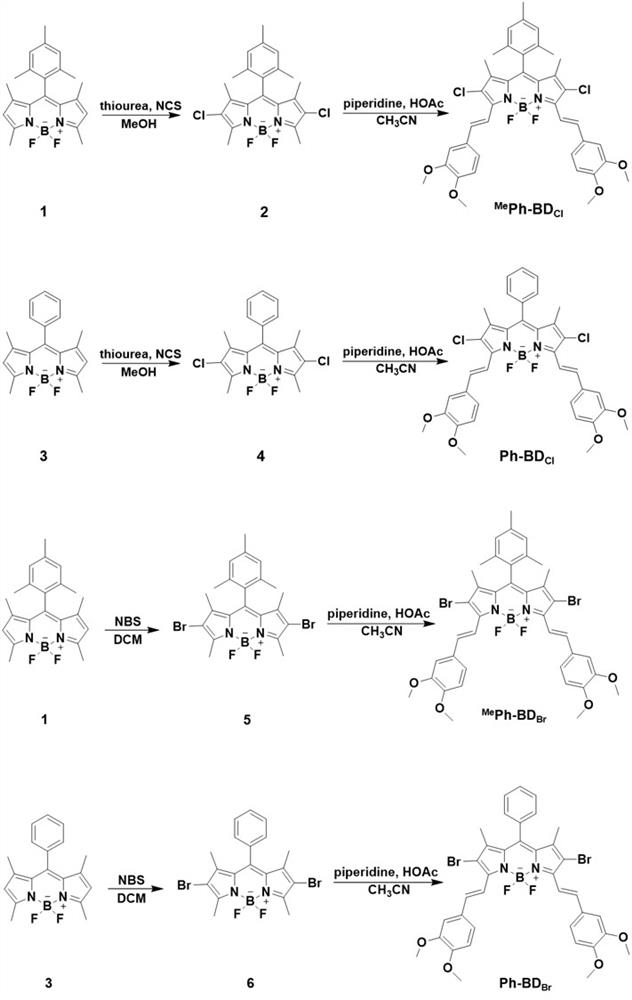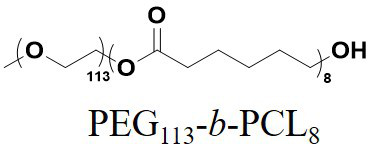Preparation method and application of j-aggregate photothermal nanoagent based on dyes and polymers
A technology of aggregates and block polymers, which is applied in the directions of photodynamic therapy, preparations for in vivo experiments, and medical preparations of inactive ingredients, etc. It can solve the problems of stability, uncertain biological toxicity, etc., and achieve the effect of constant photothermal conversion effect, outstanding photothermal stability, and good therapeutic effect.
- Summary
- Abstract
- Description
- Claims
- Application Information
AI Technical Summary
Problems solved by technology
Method used
Image
Examples
Embodiment 1
[0025] Example 1: Synthesis of Four Hydrophobic BODIPY Dye Molecules, See Attachment for Molecular Structure image 3 , the synthetic route is attached figure 1 . Synthesis of compound 2: Compound 1 (1.83 g, 5.0 mmol) and N-chlorosuccinimide (NCS) (2.0 g, 15.0 mmol) were dissolved in 100 mL of methanol, and a small amount of thiourea (0.1 g), react at 30°C for about 3h. During the period, the plate was monitored. When the compound 1 was consumed, the reaction was stopped. After the solvent was removed by rotary evaporation, the red solid product 2 (1.83g) was obtained after purification by column chromatography PE / DCM (1 / 1, v / v). The yield was 84.3%. 1 H NMR (400MHz, CDCl 3 )δ(ppm) 6.98(s, 2H), 2.58(s, 6H), 2.36(s, 3H), 2.08(s, 6H), 1.37(s, 6H).
[0026] compound Me Ph-BD Cl Synthesis. 3,4-Dimethoxybenzaldehyde (498.5 mg, 3.0 mmol) was dissolved in 50 mL of dry acetonitrile solution and a small amount of molecular sieve was added as a water scavenger, 0.5 mL of piperid...
Embodiment 2
[0033] Example 2. Dye Ph-BD Cl Method for preparing J-aggregate photothermal reagent J1: Ph-BD Cl Dissolve in dry acetone to give a saturated solution. Weigh high polymer PEG 113 -b-PCL 8 Add 200 μL of acetone to 10 mg, stir at 37°C to fully dissolve it, then add 10 mL of ultrapure water to it, stir at 37°C and 900RPM for 3 minutes, and then add Ph-BD dropwise to it quickly Cl Add 1 mL of acetone saturated solution of dye molecules, continue stirring for 24 hours under these conditions, and pass through a 0.45 μm water filter to obtain Ph-BD Cl Dye J-aggregate photothermal reagent J1 at a concentration of approximately 60 μM. Its absorption spectrum changes as follows Figure 4 shown.
Embodiment 3
[0034] Example 3. Ph-BD Br Preparation method of J-aggregate photothermal reagent J3 constructed by dyes and polymers: Ph-BD Br The molecule is dissolved in acetone to give its saturated solution. Weigh 10mg of polymer PEG 113 -b-PCL 8 , add a small amount of acetone, stir at 37 ° C to fully dissolve, then add 10 mL of ultrapure water to it, stir at 37 ° C and 900RPM for 3 min, and then quickly add 3 mL of saturated solution of BODIPY dye molecules to it, under this condition Continue stirring for 24 hours. Ph-BD can be obtained Br J-aggregate solution J2 before dye structure remodeling. Then, the solution was added to a millipore ultrafiltration tube with a filter membrane molecular weight cut-off of 10K and a volume of 15 mL, and centrifuged 6 times at 2000 RPM for 1 hour each time. After each centrifugation, the lower aqueous solution was discarded, and ultrapure water was added to the upper centrifuge tube to 15 mL, and centrifugation was continued. Finally, 0.6 mL...
PUM
 Login to View More
Login to View More Abstract
Description
Claims
Application Information
 Login to View More
Login to View More - R&D
- Intellectual Property
- Life Sciences
- Materials
- Tech Scout
- Unparalleled Data Quality
- Higher Quality Content
- 60% Fewer Hallucinations
Browse by: Latest US Patents, China's latest patents, Technical Efficacy Thesaurus, Application Domain, Technology Topic, Popular Technical Reports.
© 2025 PatSnap. All rights reserved.Legal|Privacy policy|Modern Slavery Act Transparency Statement|Sitemap|About US| Contact US: help@patsnap.com



